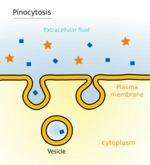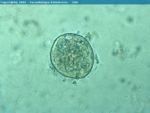Introduction
Protozoa Structure and Function
Nutrition and digestion
- Pinocytosis
- Droplets of fluid taken into the cell
- Generates small vesicles
- Usually used for extracellular fluid ingestion
- Requires ATP
- Phagocytosis
- Larger particles of matter taken into the cell
- Usually solid particles ingested
- Cell membrane envelops the fluid or food taking it into the cell
- Lysosomes fuse with the fluid/food vesicle initiating digestion
- Diffusion through the cell membrane allows excretion of metabolic products
Life Cycle
Protozoa multiply sexually, asexually and can also use a combination of both, as seen in the coccidia class. Replication can be by binary or multiple fission. Different protozoa use different forms of motility, including flagella, cilia, pseudopodia and gliding.
- Most protozoal reproduction is asexual via binary fission, schizogony and sporogony
- Some protozoa also use sexual reproduction called gametogony
- In some species, sexual and asexual reproduction occurs in the same host, whilst in others asexual reproduction occurs in the vertebrate host and sexual reproduction in the arthropod vector
- Homoxenous
- Parasite uses a single host species during its life cycle (direct)
- E.g. Eimeria
- Heteroxenous
- Parasite uses more than one host during its life cycle (indirect)
- E.g. Trypanosomes
- Facultatively heteroxenous
- Parasite may use more than one host during its life cycle but this is not essential
- E.g. Toxoplasma gondii
Example of a Protozoal Life Cycle
See Coccidia
Types
Protozoa
Protozoa are single-celled eukaryotes that can act as extracellular or intracellular parasites. While their medical importance is very high, only a small number are pathogenic for man and some, such as Toxoplasma, are only a concern in the immunodeficient.
| Extracellular | Intracellular | |
|---|---|---|
| Insect-borne | African trypanosome | Plasmodium, Leishmania |
| Water-borne | Giardia, Cryptosporiudium, Trichomonas, Isospora | Toxoplasma |
- Malaria: The malaria parasite Plasmodium grows in the gut of female mosquitoes of the Anopheles genus, eventually moving to the salivary glands. They are then transferred to a human host when she next feeds. In man, there are phases in the blood and the liver, after which the protozoa is transferred back to another feeding mosquito. There are four species of Plasmodium that can infect man, the most important in terms of mortality being P. falciparum (at least 1 million deaths a year). The major complications with this species are anaemia and cerebral malaria (a process known as sequestration- infected cells attach to vessel endothelium in the brain).
- Leishmania: Transmitted by the bite of the sandfly, this parasite is taken up by macrophages and forms either cutaneous (skin) or visceral (spleen or liver) infection. Dogs and rodents are the main reservoir.
- Trypanosomes: African trypanosome, such as T. brucei, infect many warm-blooded animals, causing 'sleeping sickness'. The South American types live for a brief period in the blood, becoming predominantly intracellular and infecting the heart and nerve fibres.
- Toxoplasma: can infect any warm blooded animal, although sexual reproductive cycles only occur in the cat. Most infections are symptomless, although this protozoa is a concern for the immunodeficient and pregnant women, causing CNS and congenital defects.
Protozoa of Veterinary Importance
Tropical Protozoa
Other Important Protozoa
Useful Resources
Brilliant microscopic pictures of protozoa and helminths
Detailed information and images, including clincial signs and pathogenesis, of East Coast Fever
Useful online resource for diagnosing parasitic infections, courtesy of the Laboratory of Parasitology, University of Pennsylvania School of Veterinary Medicine



